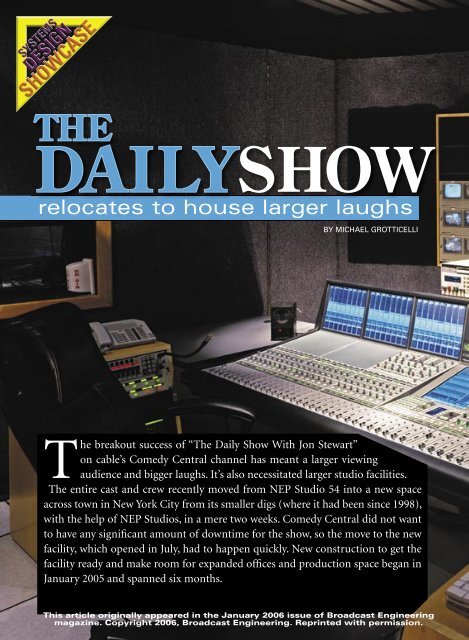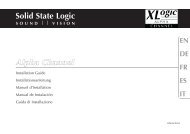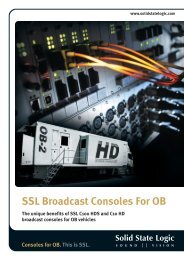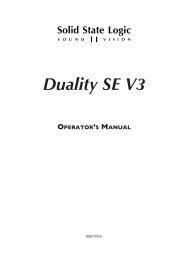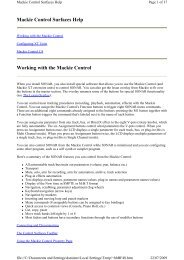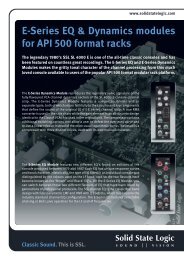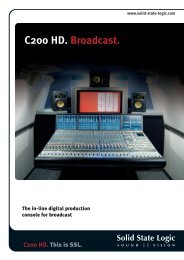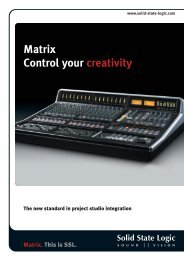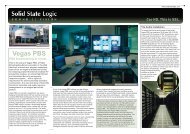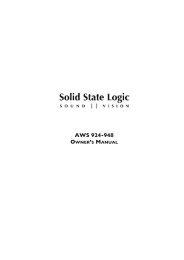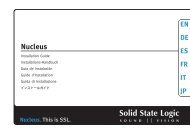Broadcast Engineering Magazine - January 2006 - Solid State Logic
Broadcast Engineering Magazine - January 2006 - Solid State Logic
Broadcast Engineering Magazine - January 2006 - Solid State Logic
You also want an ePaper? Increase the reach of your titles
YUMPU automatically turns print PDFs into web optimized ePapers that Google loves.
THE<br />
DAILYSHOW<br />
relocates to house larger laughs<br />
BY MICHAEL GROTTICELLI<br />
The breakout success of “The Daily Show With Jon Stewart”<br />
on cable’s Comedy Central channel has meant a larger viewing<br />
audience and bigger laughs. It’s also necessitated larger studio facilities.<br />
The entire cast and crew recently moved from NEP Studio 54 into a new space<br />
across town in New York City from its smaller digs (where it had been since 1998),<br />
with the help of NEP Studios, in a mere two weeks. Comedy Central did not want<br />
to have any signifi cant amount of downtime for the show, so the move to the new<br />
facility, which opened in July, had to happen quickly. New construction to get the<br />
facility ready and make room for expanded offi ces and production space began in<br />
<strong>January</strong> 2005 and spanned six months.<br />
This article originally appeared in the <strong>January</strong> <strong>2006</strong> issue of <strong>Broadcast</strong> <strong>Engineering</strong><br />
magazine. Copyright <strong>2006</strong>, <strong>Broadcast</strong> <strong>Engineering</strong>. Reprinted with permission.
The audio control room features a <strong>Solid</strong><br />
<strong>State</strong> <strong>Logic</strong> C100 digital audio console<br />
and a Digidesign Pro Tools workstation.<br />
Photos courtesy Dave King.<br />
This article originally appeared in the <strong>January</strong> <strong>2006</strong> issue of <strong>Broadcast</strong> <strong>Engineering</strong><br />
magazine. Copyright <strong>2006</strong>, <strong>Broadcast</strong> <strong>Engineering</strong>. Reprinted with permission.
NEP Studios owns the studio space<br />
and has agreed to lease it to “The<br />
Daily Show” for four years. John<br />
Chow, NEP Studios’ vice president<br />
of engineering, oversaw the engineering<br />
project, which was renovated to<br />
Comedy Central specifi cations. This<br />
includes the show’s desire to have<br />
all of the production rooms located<br />
on the same fl oor. Also, the graphics<br />
workstations are now located<br />
close to the editing systems so that the<br />
staff can collaborate on projects more<br />
effectively.<br />
The show’s producers wanted the<br />
tape operators to be able to see the<br />
control room, so a hole was cut and<br />
a window built between the two. In<br />
most cases, the show’s staff would<br />
rather communicate across the rooms<br />
to one another than send and grab a<br />
fi le off of a network. However, the<br />
staff does have access to a Telex/RTS<br />
Matrix Intercom system with wireless<br />
intercoms units.<br />
Top photo: The spacious SDI production control room employs a Sony DVS-9000<br />
switcher, a Pinnacle DVEXtreme digital video effects system, Ikegami monitoring<br />
and a Telex/RTS Matrix Intercom system.<br />
Bottom photo: The large 100ft x 75ft studio audience area accommodates more<br />
than 200 people. The set is equipped with Sony BVP-950 cameras and three large<br />
rear-projection screens.<br />
This article originally appeared in the <strong>January</strong> <strong>2006</strong> issue of <strong>Broadcast</strong> <strong>Engineering</strong><br />
magazine. Copyright <strong>2006</strong>, <strong>Broadcast</strong> <strong>Engineering</strong>. Reprinted with permission.
Chow also supervised<br />
the purchase of several<br />
new pieces of digital production<br />
equipment, as well as the<br />
transfer of existing systems to the<br />
new facilities. There’s also a new serial<br />
digital/fi ber-optic network connecting<br />
the systems and expanded space<br />
for the show’s studio audience, writers<br />
and administrative staff.<br />
The facility did not go completely<br />
digital. (It’s 601 digital and AES with<br />
analog video and audio layers.) There’s<br />
a Grass Valley Venus analog router<br />
with dozens of Grass Valley Gecko signal<br />
conversion cards and numerous<br />
Betacam SP decks in use. However, it<br />
does takes advantage of several digital<br />
islands — for editing (Avid Media<br />
Composer Adrenalines) and for graphics<br />
(Discreet fl int, Quantel Paintbox,<br />
etc.) — connected via a Gigabit Ethernet<br />
connection, that help streamline<br />
the sometimes frenetic production<br />
process. Four Avid workstations share<br />
material via a LANShare server with<br />
2.88TB of storage.<br />
Because it’s such a graphics/videointensive<br />
production, the show also<br />
uses fi ve Grass Valley M-Series iVDR<br />
(two record and two playback channels,<br />
with 16 hours of 25Mb/s storage<br />
per unit), Profi le servers (eight channels),<br />
TiVo digital video recorders and<br />
four digital betacam VTRs to capture<br />
images off-air for use in the show. The<br />
editors also use Sony DVW-M2000<br />
and DVW-A500 source decks.<br />
An analog transmission path at the<br />
old location has been converted to a<br />
DS-3 digital link. As the show is being<br />
taped live, video and audio is<br />
sent to Comedy Central’s offi ce at<br />
1515 Broadway, in New York City.<br />
Then it’s bounced to the network operations<br />
center, in Hauppauge, NY,<br />
for playout across the country.<br />
Audio also has been greatly enhanced,<br />
with a new <strong>Solid</strong> <strong>State</strong> <strong>Logic</strong> C100<br />
digital audio console serving as the<br />
centerpiece of a retrofi tted audio production<br />
room. Tim Lester, a freelance<br />
audio engineer who has been with the<br />
show since its inception, said the new<br />
console includes all of the features he<br />
The tape/server operations room looks into the production room. It uses Sony<br />
Digital Betacam, a Grass Valley M-Series iVDR, and DNF and Lance controllers.<br />
Technology at work<br />
Adobe After Effects workstation<br />
Avid Technology<br />
Media Composer Adrenaline systems<br />
LAN Share server<br />
Chyron iNFiNiT! CG<br />
Digidesign Pro Tools|HD3<br />
Discreet fl int workstation<br />
DNF Controls 2034CL Clip Instant Access System with ST 420 Shotbox<br />
ETC Expression 3-800 lighting control console<br />
Grass Valley<br />
M-Series iVDR<br />
Venus routing switcher<br />
Signal converters<br />
Ikegami<br />
14in and 17in broadcast monitors<br />
Rack-mount LCD panel<br />
Lance HSE-200 four-VTR controller-editor<br />
Leader SDI waveform/vectorscopes<br />
Mackie Onyx 1640 analog audio mixer<br />
Pinnacle Systems<br />
DVEXtreme digital video effects system<br />
Lightning stillstore<br />
Quantel Paintbox workstation<br />
Sennheiser EM 3532 wireless mics<br />
<strong>Solid</strong> <strong>State</strong> <strong>Logic</strong> C100 broadcast audio console<br />
Sony<br />
BVP-950 digital portable camera system<br />
DVS-9000 switcher<br />
DVW-M2000 Digital Betacam editor<br />
DVW-500 Digital Betacam VTRs<br />
TASCAM MX-2424 SE hard-disc recorder<br />
Tektronix SPG 422 SDI sync generator<br />
Telex/RTS Matrix Intercom systems w/wireless intercoms<br />
Vinten<br />
Vector 70 pan/tilt heads<br />
Fulmar pedestals<br />
This article originally appeared in the <strong>January</strong> <strong>2006</strong> issue of <strong>Broadcast</strong> <strong>Engineering</strong><br />
magazine. Copyright <strong>2006</strong>, <strong>Broadcast</strong> <strong>Engineering</strong>. Reprinted with permission.
wished he had in the existing facility.<br />
“The Daily Show” selected the SSL<br />
C100 due to a number of live production<br />
features. The new version 2 software<br />
includes expanded I/O capacity<br />
and TouchPan, a feature that allows<br />
Lester to have full 5.1 panning access<br />
on every channel from the console’s<br />
central touch screen. The console’s ability<br />
to handle full 5.1 surround sound<br />
mixes was another key factor in selecting<br />
the unit, as “The Daily Show” plans<br />
to begin producing the show in Dolby<br />
Digital sometime this year. Lester also<br />
uses a Digidesign Pro Tools system and<br />
a TASCAM 24-track, 24-bit hard disk<br />
recorder to create sound effects.<br />
An expanded production studio,<br />
which is the former home of The Food<br />
Network shows such as “Emeril Live,”<br />
includes four Sony BVP-950 digital<br />
cameras (with switchable aspect ratio),<br />
an ETC lighting system and a larger studio<br />
audience area. The studio audience<br />
area accommodates more than 200<br />
people, twice the amount of people the<br />
older studio held. The set also has been<br />
redesigned, with the addition of three<br />
large rear-projection screens.<br />
A renovated control room features<br />
Design team<br />
NEP Studios<br />
Charles Pontillo, president<br />
John T Chow, VP of<br />
engineering<br />
Kevin Tobin, chief engineer<br />
Studio 52<br />
Lorenzo Handsford, engineer<br />
Studio 52<br />
Adriane Truex, facility<br />
manager Studio 52<br />
Bill Willig, project manager<br />
Georgia Pappas, executive in<br />
charge of production<br />
Ray DeMartini, director of<br />
support services-<br />
engineering & facilities<br />
Kevin Tobin & Ed Modzel, design<br />
engineers<br />
Sonny Waysack, installation<br />
supervisor<br />
Alan Garry, Kossar & Garry<br />
Architects<br />
a four M/E Sony DVS-9000 SD production<br />
switcher, fully loaded with<br />
80 inputs and 48 outputs. Images are<br />
stored for each night’s show on a Pinnacle<br />
Systems Lightning server, which<br />
can be called up through the switcher<br />
for insertion into the show as well.<br />
Ikegami monitors fill out a comprehensive<br />
monitor wall, where the director<br />
and TD sit and call the shots.<br />
The new digital facility offers Jon<br />
Stewart and his staff a chance to spread<br />
their wings and produce more complex<br />
segments than they could before.<br />
The frenetic pace of producing the<br />
show is still the same, but now there<br />
is more room to roam. BE<br />
Michael Grotticelli regularly reports on<br />
the professional video and broadcast<br />
technology industries.<br />
This article originally appeared in the <strong>January</strong> <strong>2006</strong> issue of <strong>Broadcast</strong> <strong>Engineering</strong><br />
magazine. Copyright <strong>2006</strong>, <strong>Broadcast</strong> <strong>Engineering</strong>. Reprinted with permission.


